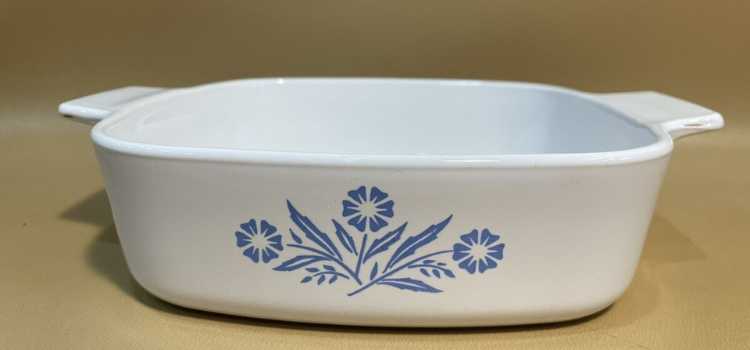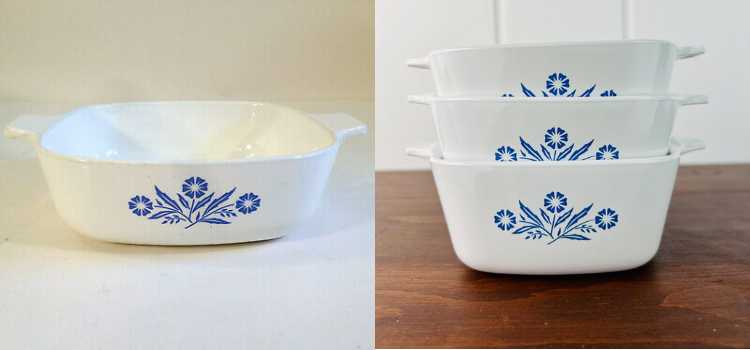As an Amazon Associate, I earn from qualifying purchases

CorningWare cookware is a name that resonates with quality and practicality. These oven-to-table dishes have stood the test of time, offering a reliable option for bakers and chefs alike. The brand’s signature aesthetic of clean, white ceramic with blue floral patterns has become a kitchen icon.
Beyond aesthetics, CorningWare is celebrated for its multifunctionality, allowing users to bake, serve, and store food effortlessly. Its ability to withstand temperature extremes makes it a favorite among those who appreciate both style and substance in their kitchenware.
Materials Used in CorningWare
Composition and Durability of CorningWare Materials
CorningWare is primarily made from a unique glass-ceramic substance known as Pyroceram. Developed by Corning Glass Works, this material was initially designed for use in missile nose cones due to its exceptional durability and thermal shock resistance.
Pyroceram can endure high temperatures and sudden changes in temperature, making it a perfect material for cookware. This toughness means that CorningWare dishes are less likely to break under thermal stress, a common concern with regular glass baking dishes.
Heat Resistance Properties of CorningWare
The heat resistance of CorningWare is one of its standout features. Pyroceram’s ability to withstand high temperatures makes it suitable for use in ovens, including broilers. Unlike some other cookware materials, CorningWare can endure temperatures up to 500°F (260°C), allowing for a wide range of cooking techniques. This heat resistance not only enhances its versatility but also reassures users of its reliability during baking and roasting.
Safety and Temperature Limits for Oven Use
Recommended Oven Temperature Limits for CorningWare
While CorningWare’s heat resistance is impressive, it’s essential to adhere to recommended temperature limits to ensure safety and preserve the integrity of the cookware. Although classic CorningWare lines can tolerate high temperatures, modern iterations, often made with stoneware or ceramic, may have different specifications.
It’s crucial to check the manufacturer’s guidelines specific to the product in use. Generally, classic CorningWare dishes are safe up to 500°F (260°C), but newer stoneware versions might be limited to 425°F (218°C).
Potential Risks and How to Mitigate Them
Using CorningWare beyond its specified temperature limits can lead to cracking or breaking, particularly with newer stoneware versions. Additionally, rapid temperature changes, such as placing a hot dish on a cold surface, can result in thermal shock, causing the dish to crack.
To mitigate these risks, it’s important to allow dishes to cool gradually and avoid placing them directly from the refrigerator or freezer into a hot oven. Using trivets or towels can help prevent direct contact with cold surfaces after cooking.
Practical Tips for Using CorningWare in the Oven

Preheating Guidelines to Prevent Damage
Proper preheating of the oven is crucial when using CorningWare to ensure even cooking and to avoid thermal shock. Place the dish in a preheated oven rather than starting with a cold oven. This practice minimizes the risk of uneven heating, which can stress the material.
Additionally, avoid sudden changes in temperature, such as moving the dish directly from a cold fridge to a hot oven.
Safe Handling Techniques During and After Baking
When handling CorningWare, use oven mitts or heat-resistant gloves to protect your hands from burns. Even though the material can withstand high temperatures, it will still be hot to the touch.
After removing the dish from the oven, place it on a heat-resistant surface like a trivet or thick kitchen towel to prevent thermal shock. Allow the dish to cool naturally before washing or storing to avoid any accidental damage.
Conclusion
CorningWare’s enduring popularity is a testament to its exceptional design and functionality. With its ability to transition seamlessly from oven to table, it offers unparalleled convenience in the kitchen. By understanding the specific material properties and adhering to recommended usage guidelines, users can safely enjoy the benefits of this versatile cookware.
FAQ
Can you put CorningWare in the oven?
Yes, you can put CorningWare in the oven. Classic CorningWare is made from Pyroceram, which can withstand temperatures up to 500°F (260°C). Always check your specific product’s guidelines, as newer versions made from different materials may have lower temperature limits.
Is Corelle CorningWare oven safe?
Corelle is distinct from CorningWare and primarily used for dinnerware. While Corelle plates and bowls are microwave and oven safe up to 350°F (177°C), they are not intended for baking or cooking like CorningWare. Always verify specific product instructions for safe usage.
Can I bake bread in CorningWare?
Absolutely, CorningWare is excellent for baking bread. Its heat resistance and even heat distribution make it suitable for achieving a good crust. Ensure your CorningWare is suitable for the oven temperature required for your bread recipe, generally up to 500°F (260°C).
Can I bake cake in CorningWare?
Yes, you can bake a cake in CorningWare. Its even heat distribution is ideal for baking. Just make sure to preheat the oven and check that your specific CorningWare piece can handle the required baking temperature, usually not exceeding 500°F (260°C).
As an Amazon Associate, I earn from qualifying purchases